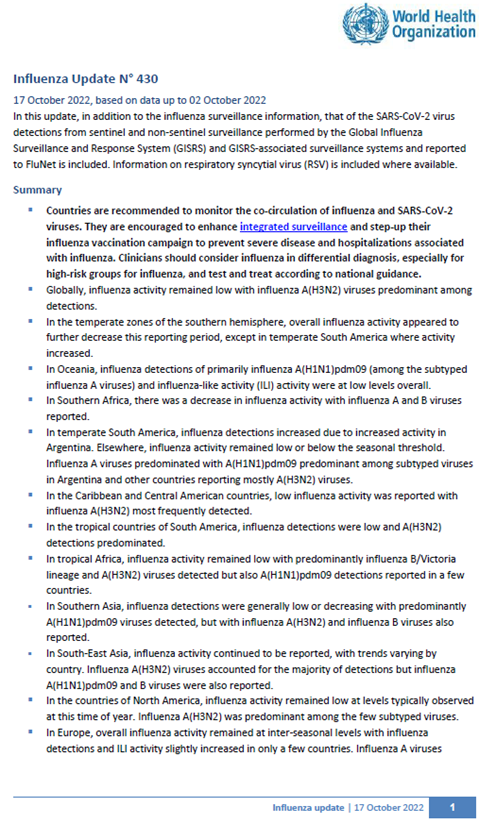Influenza Update N° 430

Overview
17 October 2022, based on data up to 02 October 2022
Information in this report is categorized by influenza transmission zones, which are geographical groups of countries, areas or territories with similar influenza transmission patterns. For more information on influenza transmission zones, see the link below:
Influenza Transmission Zones (pdf, 659kb)
- Countries are recommended to monitor the co-circulation of influenza and SARS-CoV-2 viruses. They are encouraged to enhance integrated surveillance and step-up their influenza vaccination campaign to prevent severe disease and hospitalizations associated with influenza. Clinicians should consider influenza in differential diagnosis, especially for high-risk groups for influenza, and test and treat according to national guidance.
- Globally, influenza activity remained low with influenza A(H3N2) viruses predominant among detections.
- In the temperate zones of the southern hemisphere, overall influenza activity appeared to further decrease this reporting period, except in temperate South America where activity increased.
- In Oceania, influenza detections of primarily influenza A(H1N1)pdm09 (among the subtyped influenza A viruses) and influenza-like activity (ILI) activity were at low levels overall.
- In Southern Africa, there was a decrease in influenza activity with influenza A and B viruses reported.
- In temperate South America, influenza detections increased due to increased activity in Argentina. Elsewhere, influenza activity remained low or below the seasonal threshold. Influenza A viruses predominated with A(H1N1)pdm09 predominant among subtyped viruses in Argentina and other countries reporting mostly A(H3N2) viruses.
- In the Caribbean and Central American countries, low influenza activity was reported with influenza A(H3N2) most frequently detected.
- In the tropical countries of South America, influenza detections were low and A(H3N2) detections predominated.
- In tropical Africa, influenza activity remained low with predominantly influenza B/Victoria lineage and A(H3N2) viruses detected but also A(H1N1)pdm09 detections reported in a few countries.
- In Southern Asia, influenza detections were generally low or decreasing with predominantly A(H1N1)pdm09 viruses detected, but with influenza A(H3N2) and influenza B viruses also reported.
- In South-East Asia, influenza activity continued to be reported, with trends varying by country. Influenza A(H3N2) viruses accounted for the majority of detections but influenza A(H1N1)pdm09 and B viruses were also reported.
- In the countries of North America, influenza activity remained low at levels typically observed at this time of year. Influenza A(H3N2) was predominant among the few subtyped viruses.
- In Europe, overall influenza activity remained at inter-seasonal levels with influenza detections and ILI activity slightly increased in only a few countries. Influenza A viruses predominated among the reported detections in general with A(H3N2) viruses accounting for the majority of subtyped influenza A virus detections.
- In central Asia, Kazakhstan reported a few influenza B virus detections and ILI and severe acute respiratory infections (SARI) activity increased slightly in recent weeks.
- In Northern Africa, no influenza detections were reported.
- In East Asia, influenza activity of predominantly influenza A(H3N2) remained stable in general.
- In Western Asia, detections of influenza slightly increased in some countries of the Arab Peninsula.
- National Influenza Centres (NICs) and and other national influenza laboratories from 105 countries, areas or territories reported data to FluNet for the time period from 19 September 2022 to 02 October 2022* (data as of 2022-10-14 07:38:34 UTC). The WHO GISRS laboratories tested more than 133 934 specimens during that time period. 5323 were positive for influenza viruses, of which 4706 (88.4%) were typed as influenza A and 617 (11.6%) as influenza B. Of the subtyped influenza A viruses, 630 (18.3%) were influenza A(H1N1)pdm09 and 2808 (81.7%) were influenza A(H3N2). Of the characterized B viruses, all (208) belonged to the B/Victoria lineage.
- The WHO Consultation and Information Meeting on the Composition of Influenza Virus Vaccines for Use in the 2023 Southern Hemisphere Influenza Season was held on 19-23 September 2022 in Dublin, Ireland. The recommended composition of influenza virus vaccines for use in the 2023 southern hemisphere influenza season can be consulted at the following link: https://covid.comesa.int/publications/m/item/recommended-composition-of-influenza-virus-vaccines-for-use-in-the-2023-southern-hemisphere-influenza-season.
- COVID-19 positivity from sentinel surveillance continued to decrease and remained below 10%. A decreasing trend was observed across all WHO regions except for the African, the South-East Asia and the Western Pacific regions where positivity increased compared to the previous reporting period. COVID-19 positivity from non-sentinel surveillance also continued to decline to below 10%.
- During the COVID-19 pandemic, WHO encourages countries, especially those that have received the multiplex influenza and SARS-CoV-2 reagent kits from GISRS, to conduct integrated surveillance of influenza and SARS-CoV-2 and report epidemiological and laboratory information in a timely manner to established regional and global platforms. Revised interim guidance has just been published here: https://covid.comesa.int/publications/i/item/WHO-2019-nCoV-integrated_sentinel_surveillance-2022.1.
- National Influenza Centres (NICs) and other national influenza laboratories from 53 countries, areas or territories from six WHO regions (African Region: 12; Region of the Americas: 15; Eastern Mediterranean Region: 3; European Region: 17; South-East Asia Region: 3; Western Pacific Region: 3) reported data to FluNet from sentinel surveillance sites for time period from 19 September 2022 to 02 October 2022* (data as of 2022-10-14 07:38:34 UTC). The WHO GISRS laboratories tested more than 37 422 sentinel specimens during that time period and 2693 (7.2%) were positive for SARS-CoV-2. Additionally, more than 263 563 non-sentinel or undefined reporting source samples were tested in the same period and 17 201 were positive for SARS-CoV-2. Further details are included at the end of this update.
Source of data
______________________________________________________________________________________________
The Global Influenza Programme monitors influenza activity worldwide and publishes an update every two weeks. The updates are based on available epidemiological and virological data sources, including FluNet (reported by the WHO Global Influenza Surveillance and Response System), FluID (epidemiological data reported by national focal points) and influenza reports from WHO Regional Offices and Member States. Completeness can vary among updates due to availability and quality of data available at the time when the update is developed.
*It includes data only from countries reporting on positive and negative influenza specimens.
